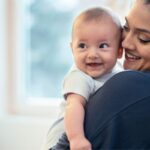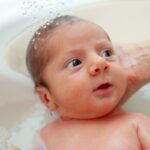We investigated the 2018 statement by The Lullaby Trust, a safe-sleeping charity, warning that baby nests and baby pods did not conform to its safer sleeping guidelines. We are aware that sleeping pods and nests can be used widely and we wanted to evaluate the scientific evidence and examine development in sleep products to answer any questions.
Made For Mums believes it is important to base information on scientific evidence. We have reviewed all research papers The Lullaby Trust has cited and have also looked at more recent scientific research.

SIDS is a real risk Baby Pods
While SIDS (Sudden Infant Death Syndrome), is very concerning, it is also extremely rare. In 2018, there were 198 SIDS cases in England and Wales (the most recent figures available). This is 0.03% of the 656,379 live-born children in England and Wales. Since 1991, SIDS cases have been declining.
Parents can take the most important and most effective step of all to ensure their baby is sleeping on their back at night and during daytime naps. Since this advice was first introduced, SIDS has seen dramatic reductions all over the globe. In the UK, SIDS dropped by 58% in 1991 after a campaign launched by FSID (now The Lullaby Trust). This campaign marketing encouraged parents to always place their baby on their back to fall asleep.
Why does The Lullaby Trust say that Baby Pods nests and babies residing in pods are not safe?
The Trust’s advice is based on nearly 200 scientific papers that it has collected since June 2019. We were informed by the Trust that this warning was based on research and not specific cases of injuries or deaths.

The Lullaby Trust’s 2019 annual report states
“Some products that are marketed to infant sleep, such a hammock, nests or pods, may not be flat and firm. The Lullaby Trust does not recommend them for use, even though their relationship with SIDS is not yet established.”
We have not been able find evidence that babies died in sleeping pods or nests outside their parent’s beds as of 2020. Seven cases were found in non-UK where babies died from co-sleeping on their parents’ beds while using a nest or pod. According to medical reports, the deaths could have been linked to nest sharing and not bed sharing.
One case of baby death by suffocation in Australia was reported in 2016. It was linked to a portable sleeping area. However, it was a padded portable crib and not a nest or pod. We will keep you informed of any incidents involving these lifestyle products.

To make this advice as clear as possible, the Lullaby Trust created a simple rule. Babies should sleep on a flat, firm, and waterproof surface. This is the rule it warns that nests and sleeping pods should not meet. These are the findings of our research.
Firm Mattress Baby Pods
What makes nests and pods not conform? Some have soft mattresses, but not all – for example, the part where your baby lies down.
Risk 1: SIDS and Suffocation may be an increased risk from soft mattresses, especially if your baby is placed on their back or rolls on their stomach.
Evidence: A soft mattress can increase the risk of SIDS and suffocation. This is most evident if a baby lies on their back or rolls onto their stomach. A study showed that a soft mattress increases SIDS risk five times.
Risk 2: According to the Lullaby Trust, “Soft surfaces can make it more difficult for babies to lose their body heat and keep a safe temperature.”
Evidence: SIDS has been associated with overheating when heavy bedding is used or the temperature in the room is too high.
What is the definition of a “non-firm” (or soft) mattress? It’s difficult to agree on the definition of a non-firm (or soft) mattress. According to the Lullaby Trust, a soft mattress should not let your baby’s head sink further than a few millimetres. According to the study, a soft mattress is one that allows a baby’s head to sink 25mm (1 in) or more. A firm mattress means that it holds its shape even after your baby is placed on the surface. Avoid memory foam mattresses

You should avoid nests or pods with a soft mattress. This can lead to SIDS and suffocation. Place a pod or nest only on a firm, flat surface.
Flat Mattress
What makes nests and Baby Podsnot conform? Baby nests are usually made with flat mattresses. However, most have raised bumper sides that are padded and positioned close to the baby’s head. Many moses baskets and carry-cots have solid padded sides that are at least the same distance as a baby nest. The Lullaby Trust currently considers Moses baskets and carry-cots safe.
Risk 1: If your baby rolls or turns over so that their nose is in the bumper, they may be at increased risk of SIDS.
Evidence: Strong evidence has been presented linking SIDS and suffocation deaths to sleep bumpers or sleep positioners. The baby’s head was found to be close to a padded side in cot bumpers. No evidence or published studies have been found yet that specifically address nests and pods.
What if the padded bumpers were breathable? Sleep pods and nests such as Sleepyhead are made from permeable and breathable element materials technology. We haven’t seen SIDS research done on these materials. According to the American Academy of Pediatrics (AAP), breathable sleeping surfaces are not considered safe.

Risk 2: We were told by the Lullaby Trust that padded bumpers could increase the chance of your baby overheating. This may lead to SIDS.
Evidence: There is no scientific evidence to support the claim that side bumpers can cause overheating. Evidence suggests that SIDS is more likely to occur when there is too much heat. These have been linked to heavy bedding and coverings that cover a baby’s head in a hot area, as well as the proximity of padded bumpers.
Bottom line: Avoid using blankets or other loose covers when putting your baby to bed. This will reduce the chance of SIDS and suffocation. You should not cover baby nests/pods with blankets. They are too small to be tucked in blankets. Make sure your baby’s room is at the right temperature (16-20°C), and that the sleeping bag is the right weight/thickness. You should check on your baby often to make sure they aren’t overheating, or that their head is not pointing towards one side.
Mattresses that are Baby Pods Waterproof
What makes nests and pods not conform? Many do not come with waterproof mattresses, and some may not have separate mattresses that can be covered with a waterproof cover.
Risk: Some mattresses can harbor bacteria that has been linked to SIDS-related illnesses. In its Safer Sleep Product Guide, the Lullaby Trust states that waterproof mattresses prevent bacteria from building up in the mattress. In its research paper, it also stated that waterproof mattresses will allow parents to clean it and keep it dry.

Evidence: There is clear evidence to suggest that SIDS may be increased by certain bacterial-based illnesses, especially upper-respiratory conditions. The theory that SIDS risk is increased by bacteria in mattresses has not been proven.
Although studies have shown that second-hand mattresses have a higher chance of SIDS, scientists are still unable to determine the cause.
A 1995 study in Scotland found that SIDS rates were not increased when mattresses were covered with PVC. Other studies, however mixed in their results, have examined how PVC covers may impact the growth and dispersal bacteria.
The official safe sleeping advice in the USA and Australia is a flat, firm mattress that has been fitted with a sheet.
What happens if the mattress has anti-bacterial properties? We have asked The Lullaby Trust whether an anti-bacterial mattress could replace waterproofing. They will reply.
Do you need a waterproof cover? Some people are concerned that waterproof covers can make a mattress less breathable, or increase the temperature which could cause your baby to sweat more. According to the Trust, if your baby is not too hot, then breathing and temperature regulation of a sleeping surface are not necessary.
This highlights the importance of being careful about your baby’s temperature while they sleep.
You should only buy waterproof covers for your mattress. Make sure it fits snugly and there are no gaps between your mattress and sides.
Bottom line: Avoid using secondhand nests or baby pods because of the danger of SIDS. There is more evidence to support the connection between SIDS and waterproof mattresses. However, it is important that you keep your mattress clean.


